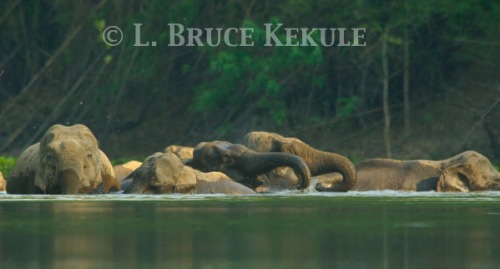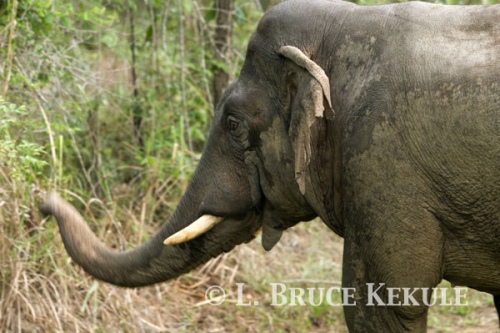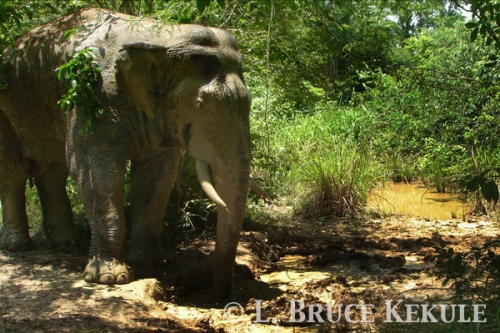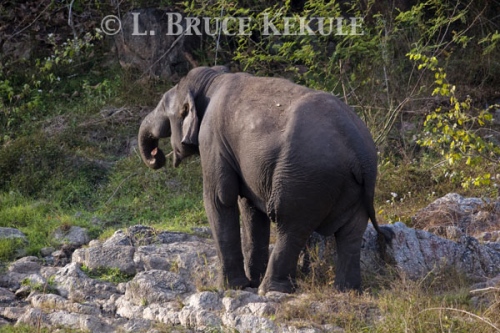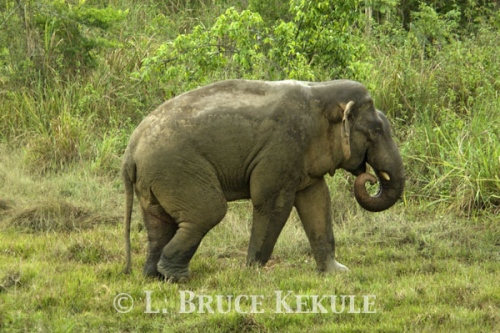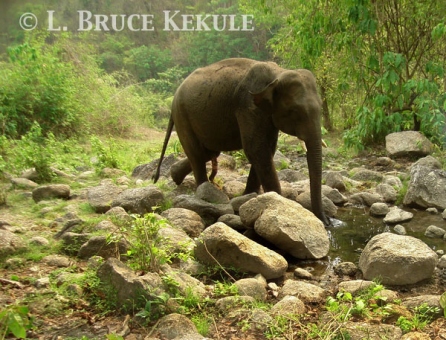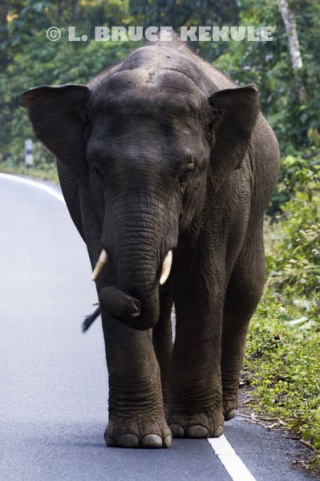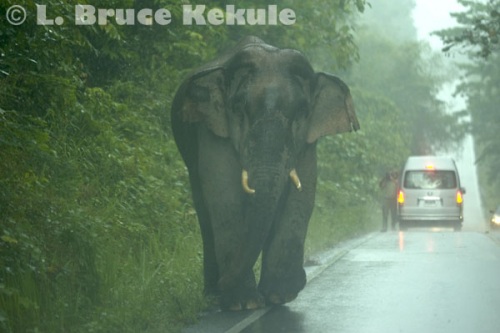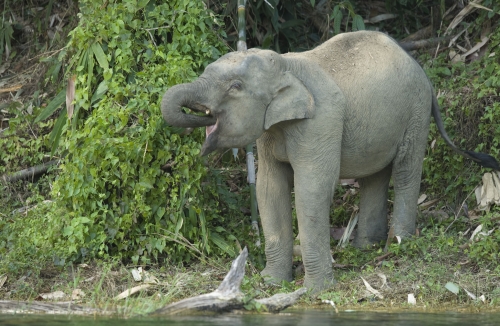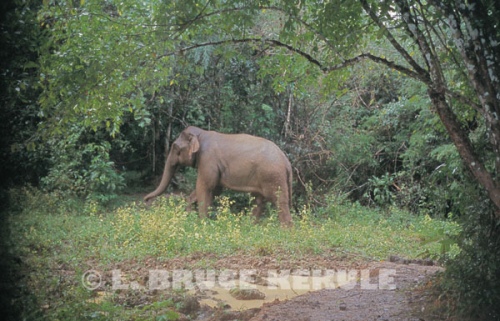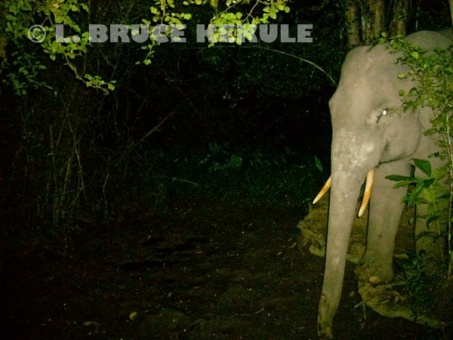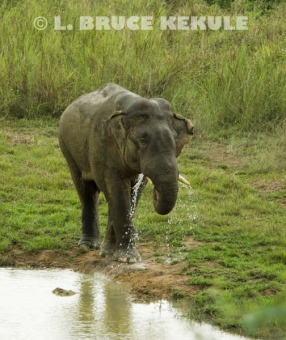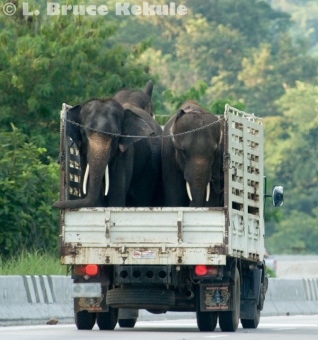Asian Elephants: Thailand’s Mega Fauna
Wild Species Report
A flagship species and cultural symbol
Thailand’s largest terrestrial animal on the brink of extinction
Wild elephant family unit in Huai Kha Khaeng Wildlife Santuary
In 1927, a film was made depicting wild Thailand, and shown to audiences around the world. Entitled ‘Chang – A Drama of the Wilderness’, this epic documentary was produced by two American filmmakers Merian C. Cooper and Ernest B. Schoedsack, and released by Famous Players-Lasky, a division of Paramount Pictures.
‘Chang’ (Thai for elephant) is a melodrama and silent film about a man, the jungle, and wild animals as its cast. The main character is Kru, a poor farmer depicted in the film that battles tigers, leopards, bears and even rampaging elephants, all of which pose a constant threat to his livelihood. The saga was depicted in the northern province of Nan where thousands of wild elephants survived in vast herds at the time. The footage of elephants in the hundreds is remarkable.
Young tusker at a mineral lick in Huai Kha Khaeng
The film also shows tigers and leopards caught in pit-falls and dispatched with a muzzleloader from the top. It was an amazing piece of celluloid production where logistics must have been really tough. Chang was nominated for an Oscar for Unique and Artistic Production at the first Academy Awards in 1929. Cooper and Schoedsack went on to make the classic blockbuster movie King Kong.
Tusker in Khao Ang Rue Nai Wildlife Sanctuary
The Asian and African elephants are the only two surviving species of a once diverse and widespread group called proboscids (order Proboscidea), or animals with a trunk. They are characterized particularly by developments of their teeth and adaptation of their limbs for supporting their increasing mass. All total there is fossil evidence of some 350 species of ancestral proboscideans, mastodons, mammoths and modern elephants.
The first ancestor of elephants lived approximately 50 million years ago during the Late Eocene and Early Oligocene Epochs. It was named Moeritherium after the place where it was discovered, the Moeris Lake in Egypt. Though its form and appearance were completely different from the elephant, scientists base Moeritherium’s ancestry of the elephant on its skull and teeth. The skull had air holes, just like the elephant, and four small incisors grew from the upper and lower jaw that the growth of tusks had begun. At least three divergent groups of proboscideans evolved there from Moeritherium or close relatives.
Mature tusker camera trapped at a waterhole in Khao Ang Rue Nai
The next beast of elephantine build and bulk was the Deinotherium that was still not a true elephant. They became common in Africa, Asia and Eastern Europe during the Miocene Epoch. They were very large at 4 meters high with down curving tusks from the lower jaw. Surviving for 20 million years well into the Pleistocene Epoch, Deinotherium was clearly a very successful animal. About the same time Paleomastodon and Phiomia began to evolve and show the closet beginnings of a trunk allowing the species to feed higher off the ground.
Very old tuskless bull in Huai Kha Khaeng
At the beginning of the Miocene epoch about 24 million years ago, the ancestral Gomphotheres was the real commencement of Proboscidean diversity. There were literally hundreds of species at one point including mastodons and mammoths. Elephantidae is the family to which the modern elephant belongs and the first species was Elephas antiquus from the middle to late Pleistocene Epoch. However, by the beginning of the Holocene Epoch around 10,000 years ago, only two species remained: African elephants Loxodonta africana and Asian elephants Elephas maximus.
Tusker in Khao Ang Rue Nai
The main differences between the two species are anatomical. The African elephant are larger and has a more elongated skull, a trunk with deep rings, larger ears, a flat forehead and, in general, holds its head at a 45 – degree angel to the ground. Asian elephants are smaller and have a double – bulged forehead, a trunk with fewer rings, smaller ears and a skull with a 90 – degree orientation.
There are three Asian sub-species: the Sri Lankan elephant Elephas maximus maximus, the mainland elephant Elephas maximus indicus, and the Sumatran elephant Elephas maximus sumatranus, and two African sub-species: the bush elephant Loxodonta africana africana, and the forest elephant Loxodonta africana cyclotis.
Young tusker camera trapped at a waterhole in Huai Kah Khaeng
Prehistoric fossil evidence of proboscideans has been discovered in the north, the northeast, the central plains, and the south of Thailand. The first find in 1948 was fossil bones of Stegodon insignis (mastodon) during the construction of the bridge across the river just south of Nakorn Sawan provincial city. Following this, discoveries were made in lignite deposits in Lamphun, Lampang and Phayao provinces. Fossil teeth of a Deinotherium at Ban Sop Khan in Phayao have been uncovered. Another find new to science is the earliest known species Stegolophodon praelatidens fossils from the Early Miocene discovered in Lamphun and Lampang by Pascal Tassy (from France) and others.
Many extraordinary ancient proboscidean fossils have been unearthed in Nakhon Ratchasima (Korat) province at the Tha Chang and Chang Thong sand pits along the Mun River in Chaloem Prakiat district going back to the middle Miocene about 16 million years ago. Eight different genera of proboscideans have been discovered here and is a testimony to the Kingdom’s fossil record.
Family unit in Huai Kha Khaeng
About 150 years ago, wild elephants were surviving around Bangkok along the Chao Phraya River, and in the districts of Rangsit, Bang Sue, Bang Kapi and Bang Na. The ‘City of Angles’ was a real jungle back then. It seems difficult to believe but in those days, Thailand was almost completely covered by forest cover – more than 90 percent. Today, only 30 percent remains. Due to the immense destruction, elephants have been at the forefront of a disappearing habitat.
The best current estimates say there are no more than 2,500-3,000 elephants surviving in the wild of Thailand today. There are 60 protected areas that have less than a hundred elephants, and another eight protected areas that have over one hundred individuals as follows: Huai Kha Khaeng Wildlife Sanctuary – 280-300; Khao Yai National Park – 200; Khao Ang Rue Nai Wildlife Sanctuary – 230; Salak Phra Wildlife Sanctuary – 175-200; Phu Luang Wildlife Sanctuary – 100; Phu Khieo Wildlife Sanctuary – 135; Kui Buri National Park – 150 and Kaeng Krachan National Park – 115. Surely, an up-to-date consensus of the wild elephant population should be undertaken by the Department of National Parks, Wildlife and Plant Conservation (DNP) in all the forests throughout the Kingdom, and a report published as soon as possible. As it stands, many of these quotes are mere guesstimates.
Young tusker on the road in Khao Yai National Park
Elephants have been persecuted for a long time. The following scenario has been chosen for this column and has been carried out for decades in Thailand’s forests, and unfortunately is the dark side of nature that carries on to this day. Gunshots reverberate explosively through the forest panicking and scattering a herd of wild elephants. The huge beasts instinctively flee as fast as they can through heavy foliage away from the cacophony. In minutes, the forest returns to normal but the sad fact is humans have just disrupted the herd permanently. A baby elephant mills aimlessly around its mother lying dead on the ground. The confused calf has no sense of danger as poachers move in and capture it to be sold on the illegal black market. The calf will likely be forced to wander city streets or work in tourist camps.
Such atrocities are still practiced by some unscrupulous people intent on killing the mother solely to capture the baby. Many other animals are also hunted down in much the same way like gibbons and monkeys. Middleman and end-use buyers perpetuate this market and seem to evade the law. Wildlife black-market trading is fueled by a few shady individuals and is on-going. Great strides have been achieved by a few wildlife enforcement agencies and many arrests have been made in recent years exposing these law-breaking individuals. However, the so-called ‘big fish’ continue to do business as usual. It is a never-ending battle!
Mature tusker on the road in Khao Yai
In another scenario, a mature bull elephant with a large set of tusks tramples and gores a man deep in a protected forest many days walk from the nearest village. News travels fast but is subdued by the authorities due to the sensitive nature of the incident. The man was with a group of poachers hunting the tusker and he was armed with a crude muzzleloader. He was separated from the group and came upon the huge herbivore firing a shot, which only enticed the old bull to charge. It was all over in seconds and when the man was found critically injured the group rushed him to the nearest medical facility but it was too late. The villagers cried fowl and hunted the old bull down eventually taking his tusks and selling them to a middleman for pennies compared to what they would fetch from a rich end-user or agent. This has been going on for ages to feed the illegal ivory trade.
Human settlement, agriculture and roads have taken over much of the elephant’s habitat. Villages spring up in old elephant terrain, and the trespassers expect the giants to simply fade away into the forest. But elephants can develop a taste for crops grown by farmers, and they often take what they want. Countless conflicts have arisen between villagers and the real owners of the land, whose ancestors have lived there for many thousands of years. Thailand is not alone to crop-raiding elephants. Other countries in Asia and Africa have experienced the same outcome when humans have taken over elephant land.
Very young tusker about five years old in Khlong Saeng Wildlife Sanctuary
Most of the conservation areas where wild elephants live are just small isolated pieces, and agricultural areas or towns surround these forests, a major obstruction to natural breeding. Elephants in each forest are caught on islands and cannot walk back and forth between these areas. Thus, inbreeding among close relatives is inevitable, which leads to an inferior population and causes genetic diseases, and ultimately, to extinction. Belinda Stewart-Cox with Elephant Conservation Network has campaigned relentlessly for the establishment of a corridor between Salakpra and Srinakarin protected areas in order to prevent the total isolation of Salakpra’s elephants. Other corridors in other parts of Thailand are on the drawing boards.
The young tusker a month earlier
Elephants have been maimed and killed by poisoning, pungee stakes and pit-falls, gunshots, and electrocution. They have been chased out of rice paddies, mango orchards, and pineapple and tapioca fields. The use of fireworks, bright lights and gunshots scare them away temporarily, but the elephants are intelligent enough to lose their fear of such ruses. Elephants grow bolder and go on the rampage, sometimes killing people, tearing up villages and damaging DNP facilities usually during the dry season when water is scarce.
Nick-named ‘Nong Saeng’ after the sanctuary
This year, a herd of wild elephants in a western national park raided a village and broke into a shack with fertilizer. A young calf gorged itself and died shortly thereafter. On the other side of the spectrum, an old tuskless bull killed a ranger in western Thailand, and a tusker gored a villager in the East. Wild elephants have also died or been injured accidently by vehicles speeding on roads in some protected areas. Most of the accidents occur at night when the elephants are difficult to see. Some conservation organizations have erected new signs in some areas warning drivers the danger of elephants on the road at night.
Mature tuskless bull in Kaeng Krachan National Park
These noble beasts have featured prominently in almost every important historical event in the Kingdom. They are national, royal, and religious icons of Thailand. The ‘white elephant’ was on the flag of Siam. They are a national symbol of pride and joy. The Thai elephant’s survival lies in the hands of those responsible for these vanishing Asian giants. Proactive conservation awareness is a top priority for the government and existing outdated laws (some a hundred years old) need to be reviewed and changed for the elephant’s future. Strict penalties and fines for poaching and encroachment need to be enforced to insure the survival of nature’s largest terrestrial mammal in Thailand before it is too late.
Ecology and behavior of elephants:
“Tractors of the forest” is what the late Mark Graham called wild elephants in his excellent book entitled ‘Thailand’s Vanishing Flora and Fauna’ co-authored by Philip Round, the eminent bird ornithologist. Graham went on to say “in all parts of Khao Yai National Park there are trails which have been used by herds of elephants for, in all probability, thousands of years”. This trait is evident throughout continental Thailand where these creatures roamed.
Tusker about 25 years old in Kaeng Krachan
Asian elephants consume 75-150 kilograms of food and about 80-160 liters of water per day. A variety of grass species including bamboo is consumed, as well as tender twigs, barks, leaves and fruit. Natural mineral deposits are also very important to these herbivores supplementing their diet. An adult mainland Asian elephant may reach a height of 3.5 meters and weigh 5,000 kilograms. Elephants form family units but lone bulls are common. Male elephants have tusks but tuskless bulls are now quite common and can be very bad tempered, especially if the bull is in a state known as ‘musth’ where fluid leaks from the temporal gland.
Mature tusker at a waterhole in Khao Ang Rue Nai
Reproduction of the Asian elephant is the same as the other sub-species. The young are born after a gestation period of 18-22 months. Elephants usually give birth to a single offspring, rarely twins, and more rarely triplets. A female elephant can give birth every 4-6 years, and has the potential of giving birth to seven offspring in her life. Life expectancy for elephants is 60-70 years.
Elephants in domestication:
Elephants are extremely intelligent creatures. For centuries, humans have taken elephants from the wild and turned them into many different uses such as war elephants, working elephants at logging sites, as pets, tourist attractions and street beggers.
Elephant on the highway in Ayuttaya province
My very close friend Richard Lair who works for the Forest Industry Organization at the Conservation Center in Lampang has worked with elephants for many years. He was the first to get elephants to paint in Thailand, and the first in the world to establish a musical band made up entirely of elephants. He has produced several CD’s of this accomplishment.
Begging elephant near the 700 year stadium in Chiang Mai
Probably the most appalling fate for a domesticated elephant is to become a ‘street walker’. These magnificent creatures are forced to saunter hot, dusty and polluted streets of Thai cities ‘begging’ for food and money. Stories about elephants hit by cars and falling into drainage ditches, plus other accidents have been documented. At one time, a trip at night around Bangkok and other cities in the Kingdom one was greeted by a huge gray beast with a red light and a flashing CD attached to its tail. Continuous calls for change went unnoticed by mahouts and the owners of these elephants who sneaked them into cities and tourist sites. Legislation concerning domesticated elephants remains old and out-dated, and law enforcement has also been very poor.
Domesticated elephants being trucked into Chiang Mai
In late-2010, I saw an elephant on the streets of Chiang Mai at night. I took a few photographs but just watched as the mahout and elephant went about their business of begging for money. However, the situation has improved and there are several new sanctuaries dedicated to helping both mahout and elephant. It seems that most of the elephants have left Bangkok but they are still found in the out-lying areas. Hopefully, one day, the street-walker will be a thing of the past and these magnificent creatures will be treated with the respect, love and admiration they deserve.
Elephant with handlers on the streets of Chiang Mai – An abstract


